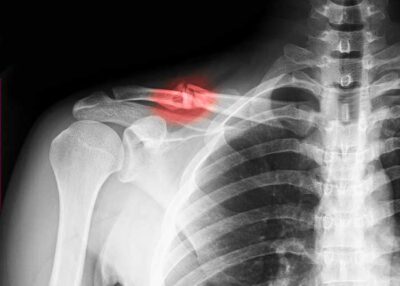Clavicle Fracture Specialist

Do you play contact sports or have you been in an accident that caused a direct blow to your collarbone? A clavicle or collarbone fracture can cause sharp pain at the time of injury, pain when moving the arm, swelling, bruising, tenderness, and stiffness of the shoulder. Collarbone fracture specialist Doctor Matthew Provencher, provides diagnosis and both surgical and nonsurgical treatment options for patients in Vail, Aspen, Colorado Springs, and the Denver, Colorado area who are experiencing symptoms of a broken clavicle or collarbone. Contact Dr. Provencher’s team today!
What is a clavicle fracture?
The clavicle, more commonly known as the collarbone, is an S-shaped bone that lies horizontally at the top of the thorax. The clavicle functions as a strut, between the sternum and scapula (shoulder blade), designed to oppose forces that would bring the upper limb toward the thorax. The range of motion of the upper limb is reliant on this function of the clavicle. When the shoulder girdle experiences a blunt force trauma, such as a direct blow or a fall onto an outstretched arm, the clavicle can become easily broken. A clavicle fracture is a common condition accounting for 5% of all adult bone fractures. Dr. Matthew T. Provencher, orthopedic shoulder specialist serving patients in Vail, Aspen, Colorado Springs, and the Denver, Colorado area, has the knowledge and understanding, as well as substantial experience in treating patients who have experienced a clavicle fracture.
Are there different types of clavicle fractures?
A clavicle fracture is classified by the following anatomical location of the fracture:
- The middle of the clavicle bone is fractured and is the most common type of clavicle fracture.
- Lateral/Distal. The area of the clavicle furthest away from the body’s midline, near the top of the scapula, is fractured.
- The rarest type of clavicle fracture, accounting for only 2-4% of all clavicle fractures, occurs when the area of the clavicle closest to the neck is fractured.
Are certain populations more at risk for a clavicle fracture?
Even though clavicle fractures are predominantly the result of a traumatic event, the following groups of individuals are at a greater risk of experiencing a clavicle fracture:
- Individuals who participate in contact sports or high-impact activities, especially males, are three times more likely to experience a clavicle fracture.
- Children and Teens. Between the ages of 10 and 19, the bones are still growing and thus have a lower density.
- Older Adults. Because bone density decreases with the natural aging process, even minor injuries can result in a clavicle fracture.
What are the symptoms of a clavicle fracture?
One of the most common complaints of a clavicle fracture is a sharp pain of the clavicle immediately following an injury. Although symptoms can vary with the severity of the injury, other common symptoms of a clavicle fracture include:
- Pain with arm movement
- Shoulder stiffness
- Obvious visual deformity of the clavicle
- Difficulty with lifting or rotating the affected arm
- Downward shoulder sag
- Tenderness, inflammation, and bruising of the affected clavicle
How is a clavicle fracture or broken collarbone diagnosed?
Dr. Provencher will obtain a comprehensive medical history to include the initial injury and any other pertinent medical conditions. A thorough physical examination will also be performed at the office visit. An x-ray will be completed to confirm the clavicle fracture diagnosis. Additional diagnostic imaging, such as CT scan or magnetic resonance imaging (MRI), may be recommended to identify damage to any other structures of the shoulder girdle.
What is the treatment for a clavicle fracture?
Non-surgical treatment:
When a clavicle fracture does not result in bone displacement, conservative therapies may be sufficient in alleviating symptoms during the healing process. The shoulder will be immobilized with the clavicle in the correct anatomical position. Pain and inflammation can be controlled with a combination of rest, ice, and non-steroidal anti-inflammatory medications (NSAIDs). When appropriate, Dr. Provencher will prescribe a physical rehabilitation program focused on increasing motion and strengthening the shoulder girdle.
Surgical treatment:
Surgical intervention is usually necessary for patients that experience a dislocated clavicle, bone displacement, a clavicle fracture that breaks through the skin, or in the event of failed conservative therapy. A clavicle fracture is surgically repaired using special plates, pins, and/or screws to realign the bone fragments into the correct anatomical configuration.
For more information on clavicle fractures, or the excellent treatment options available, please contact the office of Dr. Matthew T. Provencher, MD, orthopedic shoulder specialist at The Steadman Clinic, serving Vail, Aspen, Colorado Springs, and the Denver, Colorado area.
